c_中timer控件的使用
详解C#中的System.Timers.Timer定时器的使用和定时自动清理内存应用

详解C#中的System.Timers.Timer定时器的使⽤和定时⾃动清理内存应⽤项⽬⽐较⼤有时候会⽐较卡,虽然有GC⾃动清理机制,但是还是有不尽⼈意的地⽅。
所以尝试在项⽬启动⽂件中,⼿动写了⼀个定时器,定时清理内存,加快项⽬运⾏速度。
public class Program{[DllImport("psapi.dll")]static extern int EmptyWorkingSet(IntPtr hwProc); //清理内存相关static void Main(){//启动定时清理内存SetTimer();}/// <summary>/// 定时清理内存/// </summary>private static void SetTimer(){System.Timers.Timer aTimer = new System.Timers.Timer(); //初始化定时器aTimer.Interval = 60000;//配置时间1分钟aTimer.Elapsed += new System.Timers.ElapsedEventHandler(OnTimedEvent);aTimer.AutoReset = true;//每到指定时间Elapsed事件是到时间就触发aTimer.Enabled = true; //指⽰ Timer 是否应引发 Elapsed 事件。
}//定时器触发的处理事件private static void OnTimedEvent(Object source, ElapsedEventArgs e){//清理内存GC.Collect();GC.WaitForPendingFinalizers();Process[] processes = Process.GetProcesses();foreach (Process process in processes){//以下系统进程没有权限,所以跳过,防⽌出错影响效率。
timer的用法

Timer的用法Timer的用法主要包括以下几个方面:1.schedule方法:这是Timer类中最重要的方法之一,用于在指定的时间后执行一个任务。
它接受两个参数:第一个参数是要执行的任务,通常是一个TimerTask 对象;第二个参数是延迟时间,以毫秒为单位。
例如,以下代码会在2000毫秒后执行指定的任务:java复制代码Timer timer = new Timer();TimerTask task = new MyTask();long delay = 2000;timer.schedule(task, delay);2.scheduleAtFixedRate方法:这个方法用于定期执行一个任务。
它接受三个参数:第一个参数是要执行的任务;第二个参数是首次执行的延迟时间;第三个参数是两次执行之间的间隔时间。
例如,以下代码会每隔2000毫秒执行一次指定的任务:java复制代码Timer timer = new Timer();TimerTask task = new MyTask();long delay = 2000;long period = 2000;timer.scheduleAtFixedRate(task, delay, period);3.cancel方法:这个方法用于取消所有已安排的任务。
调用这个方法后,所有已安排的任务将不再执行。
例如,以下代码将取消所有已安排的任务:java复制代码timer.cancel();以上就是Timer的主要用法。
需要注意的是,Timer并不保证任务的执行顺序,如果需要按照特定顺序执行任务,应该使用ScheduledExecutorService等更高级的并发工具。
c中timer的用法

c中timer的用法
1. clock(函数:
示例代码:
```
#include <stdio.h>
int mai
clock_t t;
int i;
t = clock(;
//程序执行的代码
}
t = clock( - t;
return 0;
}
```
在上面的示例中,程序会测量for循环的执行时间,并将结果打印在屏幕上。
在计算程序执行时间时,需要将时钟周期转换为秒,可以通过“CLOCKS_PER_SEC”宏实现。
示例代码:
```
#include <stdio.h>
int mai
return 0;
}
```
在上面的示例中,程序将打印出当前系统时间。
除了上述基本的定时器函数之外,还有其他一些函数和方法可用于测量和处理时间:
- sleep(函数:可以让程序暂停指定的秒数。
-使用时钟频率:通过计算指令执行的时间来测量程序的执行时间。
- 使用操作系统提供的工具和库:大多数操作系统都提供了用于测量程序执行时间的工具和库,例如Windows的QueryPerformanceCounter(函数、Linu某的getrusage(函数等。
总而言之,定时器是一个在C语言中测量程序执行时间和跟踪性能的重要工具。
与操作系统提供的其他工具和库相结合,我们可以更准确地衡量我们的程序的性能,并优化我们的代码。
希望这篇文章对你理解C语言中定时器的相关用法有所帮助!。
timer_settime使用方法

timer_settime使用方法`timer_settime` 是一个在 POSIX 操作系统中用于设置定时器的函数。
这个函数允许你设置一个定时器,当定时器到达指定的时间时,它会产生一个信号或调用一个指定的回调函数。
下面是 `timer_settime` 函数的原型:```cint timer_settime(timer_t timerid, int flags, const struct itimerspec new_value, struct itimerspec old_value);```参数说明:`timerid`:这是由 `timer_create` 函数返回的定时器标识符。
`flags`:这个参数用于控制函数的操作方式。
通常设置为 0,除非有特定的需求。
`new_value`:指向一个 `itimerspec` 结构的指针,该结构指定了新的定时器时间值。
`old_value`:指向一个 `itimerspec` 结构的指针,该结构用于存储旧的定时器时间值。
如果不需要旧的定时器时间值,可以设置为 NULL。
`itimerspec` 结构定义如下:```cstruct itimerspec {struct timespec it_interval; // 下一个间隔时间struct timespec it_value; // 首次到期时间};```使用示例:下面是一个简单的示例,演示如何使用 `timer_settime` 函数设置一个定时器,使其在 5 秒后触发一次,然后每 2 秒触发一次:```cinclude <>include <>include <>include <>include <sys/>include <>void timer_handler(int sig) {printf("Timer expired!\n");}int main() {timer_t timerid;struct sigaction sa;struct itimerspec its;struct timeval tv;int ret;// 设置信号处理函数_flags = SA_SIGINFO;_sigaction = timer_handler;sigemptyset(&_mask);if (sigaction(SIGRTMIN, &sa, NULL) == -1) {perror("sigaction");exit(EXIT_FAILURE);}// 创建定时器timerid = timer_create(CLOCK_REALTIME, NULL, &timerid); if (timerid == (timer_t)-1) {perror("timer_create");exit(EXIT_FAILURE);}// 设置定时器时间值__sec = __sec = 2; // 首次到期时间为 2 秒,之后每 2 秒触发一次 __nsec = __nsec = 0; // 纳秒部分设置为 0ret = timer_settime(timerid, 0, &its, NULL);if (ret == -1) {perror("timer_settime");exit(EXIT_FAILURE);}// 主循环,等待信号处理函数被调用pause(); // 或者使用其他方式等待信号处理函数被调用,例如使用信号量或条件变量等机制。
VC环境下C语言定时器的使用

VC环境下C语言定时器的使用当前的rae终端软件是用vc开发的,源文件中既有C++又有C。
C++的定时器使用SetTimer,该定时器需要消息机制来触发;C中的定时器依赖于不同的操作系统(多数C语言编译器不支持多线程,而且ANSI C也没有线程库,因此C语言无法实现实际意义上的定时器(即包含触发机制的定时器)),在vxworks中可用watchdog,而在windows下,SetTimer的使用依赖于消息循环,因此最好使用自定义的timer。
在自己所了解的C语言软件框架中,都使用了自定义的timer。
例如,7号信令,trillium中都是在一个独立的线程中处理与定时有关的操作。
当定时器超时,根据指针函数调用相应的回调函数。
以下所列为从网上摘抄的简单例子。
timer.h#ifndef __TIMER_H__#define __TIMER_H__typedef void (*timer_callback)(void *);typedef struct timer * timer;#define TIMER_INACTIVE 0x00000000UL#define TIMER_ACTIVE 0x00000001ULunsigned long timer_init( void );timer timer_create( const char * name, timer_callbackcb, void * param, unsigned long ticks, unsigned long remain, unsigned long status );void timer_del( timer *tp );unsigned long timer_task_del( void );#endif /*__TIMER_H__*/timer.c#include <windows.h>#include "timer.h"struct timer {struct timer * next;struct timer * prev;LPCSTR timer_name;LPVOID timer_param;ULONG timer_id;ULONG timer_counts;ULONG timer_remain;ULONG timer_status;timer_callback tcb;};static timer timer_head = NULL;static HANDLE hTimer = 0;static DWORD dwTimer = 0;static BOOL flag = TRUE;#define INT_DISABLE#define INT_ENABLEstatic timer timer_find( timer tp ){timer p = timer_head;timer rp = NULL;while ( p ) {if ( p->next == tp ) { rp = p;break;}p = p->next;}return rp;}static void timer_add( timer tp ){timer p = timer_find( NULL );if ( p == NULL ){timer_head = tp;return;}else{p->next = tp;p->next->prev = p;}}void timer_del( timer *tp ){timer p = *tp;if ( ( tp == NULL ) || ( *tp == NULL ) ) {return;}if ( p->prev ) {p->prev->next = p->next;}else {timer_head = p->next;}if ( p->next ) {p->next->prev = p->prev;}free( p );*tp = NULL;}DWORD WINAPI timer_task( LPVOID param ){timer p = NULL;while ( flag ) {Sleep( 10 );p = timer_head;while ( p ) {if ( ( p->timer_status & TIMER_ACTIVE ) && ( !--p->timer_remain ) ) {p->timer_remain = p->timer_counts;(p->tcb)(p->timer_param);}p = p->next;}}return 0;}unsigned long timer_init( void ){hTimer = CreateThread( NULL, 0, timer_task, NULL, 0, &dwTimer );if ( hTimer == NULL ) {return 0;}return 1;}unsigned long timer_task_del( void ){timer p = NULL;timer tp = NULL;if ( hTimer != NULL ) {flag = FALSE;WaitForSingleObject( hTimer, INFINITE ); CloseHandle( hTimer );hTimer = NULL;dwTimer = 0;}p = timer_head;while ( p ) {tp = p->next;free( p );p = tp;}timer_head = NULL;return 1;}timer timer_create( const char * name, timer_callbackcb, void * param, unsigned long ticks, unsigned long remain, unsigned long status ){timer p = NULL;p = malloc( sizeof( struct timer ) ); if ( p != NULL ) {p->next = NULL;p->prev = NULL;p->tcb = cb;p->timer_param = param;p->timer_counts = ticks;p->timer_remain = remain;p->timer_status = status;p->timer_name = name;timer_add( p );}return p;}test.c#include <windows.h>#include <stdio.h>#include "timer.h"void ctimer_expire( void * p ){printf( "ctimer_expire\n" );}void ptimer_expire( void * p ){printf( "ptimer_expire\n" );}void ttimer_expire( void * p ){printf( "ttimer_expire\n" );}void main(){timer ctimer = NULL;timer ptimer = NULL;timer ttimer = NULL;timer_init();ctimer = timer_create( "ctimer_expire", ctimer_expi re, NULL, 100, 100, TIMER_ACTIVE );ptimer = timer_create( "ptimer_expire", ptimer_expi re, NULL, 30, 30, TIMER_ACTIVE );ttimer = timer_create( "ttimer_expire", ttimer_expi re, NULL, 20, 20, TIMER_ACTIVE );while ( 1 ){Sleep(1000);}timer_task_del();}以下为依赖于消息机制的SetTimer的用法:#include <windows.h>#include <iostream>using namespace std;const UINT uiTimerID = 10;VOID CALLBACK FooTimerFun( HWND, UINT, UINT, DWORD ){static int nCount = 0;cout << "Timer Function , nCount = " << nCount ++ << endl;if( nCount > 5 )PostQuitMessage(0);}int main(){MSG msg;SetTimer(NULL, uiTimerID, 1000, FooTimerFun);while (GetMessage(&msg, NULL, 0, 0)){TranslateMessage(&msg); DispatchMessage(&msg); }KillTimer(NULL, uiTimerID);return 0;}特别声明:1:资料来源于互联网,版权归属原作者2:资料内容属于网络意见,与本账号立场无关3:如有侵权,请告知,立即删除。
定时器Timer

首页 »软件开发 » VS2010/MFC编程入门之四十四(MFC常用类:定时器Timer)VS2010/MFC编程入门之四十四(MFC常用类:定时器Timer)分类标签: 编程入门VS2010VC++MFC前面一节鸡啄米讲了CTime类和CTimeSpan类的使用,本节继续讲与时间有关的定时器。
定时器并不是一个类,主要考虑到,提起时间的话就不能不说定时器,所以就把它放到CTime和CTimeSpan之后讲解。
定时器简介定时器,可以帮助开发者或者用户定时完成某项任务。
在使用定时器时,我们可以给系统传入一个时间间隔数据,然后系统就会在每个此时间间隔后触发定时处理程序,实现周期性的自动操作。
例如,我们可以在数据采集系统中,为定时器设置定时采集时间间隔为1个小时,那么每隔1个小时系统就会采集一次数据,这样就可以在无人操作的情况下准确的进行操作。
MFC定时器VS2010编程中,我们可以使用MFC的CWnd类提供的成员函数SetTimer实现定时器功能,也可以使用Windows API函数SetTimer来实现。
两者使用方法实际上很类似,但也有不同。
CWnd类的SetTimer成员函数只能在CWnd类或其派生类中调用,而API函数SetTi mer则没有这个限制,这是一个很重要的区别。
因为本教程主要是讲解MFC编程,所以这里就先重点讲解MFC定时器的用法,关于API函数SetTimer的用法鸡啄米会在MFC定时器讲解的基础上进行延伸。
鸡啄米下面分步骤给出使用MFC定时器的方法。
1、启动定时器。
启动定时器就需要使用CWnd类的成员函数SetTimer。
CWnd::SetTimer的原型如下:UINT_PTR SetTimer(UINT_PTR nIDEvent,UINT nElapse,void (CALLBACK* lpfnTimer)(HWND,UINT,UINT_PTR,DWORD));参数nIDEvent指定一个非零的定时器ID;参数nElapse指定间隔时间,单位为毫秒;参数lpfnTimer指定一个回调函数的地址,如果该参数为NULL,则WM_TIMER消息被发送到应用程序的消息队列,并被CWnd对象处理。
Timer 控件

在 Windows 应用程序中常常要用到时间控制的功能,如在程序界面上显示当前时间,或者每隔多长时间触发一个事件,等等.而 Visual Basic 中的 Timer(时间)控制器就是专门解决这方面问题的控件.Timer 控制器在工具箱面板上的图标如图一:图一选中时钟控制器,将鼠标移到界面设计区,在窗体中拖出一个矩形就可以创建一个 Timer 控件了.跟其他控件不同的是,无论你绘制的矩形有多大,Timer 控件的大小都不会变,如图二:图二另外,Timer 控件只有在程序设计过程中看得见,在程序运行时是看不见的.一、Timer 控件的属性:Timer 控件可以使用 Name 属性与 Enabled 属性,但最重要的是 Interval 即时间间隔属性.Interval 属性决定了时钟事件之间的间隔,以毫秒为单位,取值范围为 0 ~ 65535 ,因此其最大时间间隔不能超过 65 秒,即一分钟多一点的时间.如果把 Interval 属性设置为1000 ,则表示每秒钟触发一个 Timer 事件.其语法格式:Timer.Interval = X ,其中,X 代表具体的时间间隔.二、Timer 控件的 Timer (定时)事件:当一个 Timer 控件经过预定的时间间隔,将激发计时器的 Timer 事件.使用 Timer 事件可以完成许多实用功能,如显示系统时钟、制作动画,等等.三、示例:有如图三这样一个应用程序,标签能够自动显示当前时间.图三1、创建程序界面:界面如图四,为了便于大家观看,我们将 LblShow 的边界类型设为 1 . 另外,别忘了把 Timer1 的 Interval 属性设置为 1000 .图四2、在 Timer1 的 Timer 事件中输入以下代码:Private Sub Timer1_Timer()LblShow.FontSize = 30LblShow.FontName = "宋体"LblShow.Caption = "当前时间为:" & TimeEnd Sub注意,Time 是 Visual Basic 中的关键詞,表示显示系统时间.。
winform system.threading.timer 用法

winform system.threading.timer 用法System.Threading.Timer 是 .NET Framework 中用于实现定时任务的一个类。
在 WinForms 中,我们经常使用 Timer 控件来实现定时功能,但其实 Timer 控件底层也是使用了 System.Threading.Timer类来实现的。
本文将详细介绍 System.Threading.Timer 的用法。
一、Timer 类概述Timer 类是一个抽象类,用于创建定时器对象。
它提供了两种类型的计时器:1. 间隔定时器:定时器对象在指定的时间间隔后触发一次事件。
2. 重复定时器:定时器对象在指定的时间间隔后触发事件,并重复执行直到取消。
1. 创建 Timer 对象要使用 System.Threading.Timer 类,首先需要创建一个继承自Timer 类的新类,并实现 OnTimer 方法来处理定时器触发的事件。
然后,使用 Timer 的实例化方法来创建 Timer 对象。
示例代码:```csharppublic class MyTimer : Timer{private object _lock = new object();private Action _callback;public MyTimer(Action callback) : base() // 使用空参构造方法创建 Timer 对象{_callback = callback;}protected override void OnTick(object state){lock (_lock){_callback?.Invoke(); // 在临界区内调用回调方法}}}```在上面的示例代码中,我们创建了一个 MyTimer 类,它继承自Timer 类并重写了 OnTick 方法。
在 OnTick 方法中,我们使用 lock 语句来确保在多线程环境下回调方法的正确执行。
vb中timer控件的用法

VB中Timer控件的用法1. 什么是Timer控件?Timer控件是Visual Basic(VB)中的一种控件,用于在程序中创建定时器。
定时器是一种用于在特定时间间隔内执行某些操作的工具。
Timer控件可用于执行重复性的任务,如更新UI、执行后台操作等。
2. Timer控件的属性和方法2.1 属性•Enabled:指示Timer控件是否启用。
当Enabled属性设置为True时,定时器开始计时;当设置为False时,定时器停止计时。
•Interval:指定定时器的时间间隔,以毫秒为单位。
例如,设置Interval 为1000表示定时器每隔1秒触发一次。
•Tag:用于存储和检索与Timer控件相关的自定义数据。
2.2 方法•Start():启动定时器,使其开始计时。
•Stop():停止定时器,使其停止计时。
•ToString():将Timer控件的当前状态转换为字符串。
3. Timer控件的事件3.1 Tick事件Tick事件是Timer控件的主要事件,每当定时器的时间间隔过去后,Tick事件就会触发一次。
可以通过在Tick事件处理程序中编写代码来执行所需的操作。
例如,更新UI、执行后台操作等。
下面是一个示例代码,演示了如何在Tick事件中更新Label控件的文本:Private Sub Timer1_Tick(ByVal sender As System.Object, ByVal e As System.Event Args) Handles Timer1.TickLabel1.Text = DateTime.Now.ToString("HH:mm:ss")End Sub在上述代码中,Timer1是一个已经放置在窗体上的Timer控件,Label1是一个已经放置在窗体上的Label控件。
每当Timer1的时间间隔过去后,Tick事件就会触发一次,更新Label1的文本为当前的时间。
CMFC中定时器的使用
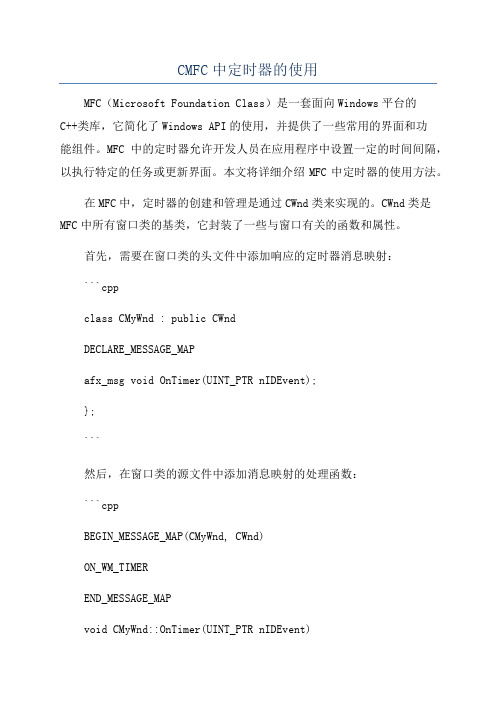
CMFC中定时器的使用MFC(Microsoft Foundation Class)是一套面向Windows平台的C++类库,它简化了Windows API的使用,并提供了一些常用的界面和功能组件。
MFC中的定时器允许开发人员在应用程序中设置一定的时间间隔,以执行特定的任务或更新界面。
本文将详细介绍MFC中定时器的使用方法。
在MFC中,定时器的创建和管理是通过CWnd类来实现的。
CWnd类是MFC中所有窗口类的基类,它封装了一些与窗口有关的函数和属性。
首先,需要在窗口类的头文件中添加响应的定时器消息映射:```cppclass CMyWnd : public CWndDECLARE_MESSAGE_MAPafx_msg void OnTimer(UINT_PTR nIDEvent);};```然后,在窗口类的源文件中添加消息映射的处理函数:```cppBEGIN_MESSAGE_MAP(CMyWnd, CWnd)ON_WM_TIMEREND_MESSAGE_MAPvoid CMyWnd::OnTimer(UINT_PTR nIDEvent)switch (nIDEvent)case 1://处理定时器1的逻辑break;case 2://处理定时器2的逻辑break;default:break;}CWnd::OnTimer(nIDEvent);```在窗口类的构造函数中,可以通过调用CWnd类的SetTimer函数来创建定时器:```cppCMyWnd::CMyWndSetTimer(1, 1000, NULL); // 创建ID为1的定时器,时间间隔为1000msSetTimer(2, 2000, NULL); // 创建ID为2的定时器,时间间隔为2000ms```在窗口类的析构函数中,需要调用CWnd类的KillTimer函数来销毁定时器:```cppCMyWnd::~CMyWndKillTimer(1); // 销毁ID为1的定时器KillTimer(2); // 销毁ID为2的定时器```通过上述代码,我们可以在窗口类中创建和管理多个定时器,并且可以在OnTimer函数中根据定时器的ID来处理相应的逻辑。
VC 中CTime的用法 时间操作

VC++中CTime的用法时间操作VC++中CTime的几种用法:获得当前日期和时间CTime tm=CTime::GetCurrentTime();CStringstr=tm.Format("%Y-%m-%d");在VC中,我们可以借助CTime时间类,获取系统当前日期,具体使用方法如下:CTime t = CTime::GetCurrentTime(); //获取系统日期intd=t.GetDay(); //获得几号int y=t.GetYear(); //获取年份int m=t.GetMonth(); //获取当前月份int h=t.GetHour(); //获取当前为几时int mm=t.GetMinute(); //获取分钟ints=t.GetSecond(); //获取秒int w=t.GetDayOfWeek(); //获取星期几,注意1为星期天,7为星期六如果想计算两段时间的差值,可以使用CTimeSpan类,具体使用方法如下:CTime t1( 1999, 3, 19, 22, 15, 0 );CTime t =CTime::GetCurrentTime();CTimeSpan span=t-t1; //计算当前系统时间与时间t1的间隔int iDay=span.GetDays(); //获取这段时间间隔共有多少天intiHour=span.GetTotalHours(); //获取总共有多少小时int iMin=span.GetTotalMinutes();//获取总共有多少分钟int iSec=span.GetTotalSeconds();//获取总共有多少秒设置计时器定义TIMER ID#define TIMERID_JISUANFANGSHI 2在适当的地方设置时钟,需要开始其作用的地方;SetTimer(TIMERID_JISUANFANGSHI,200,NULL);在不需要的时候销毁掉时钟KillTimer(TIMERID_JISUANFANGSHI);消息映射void CJisuan::OnTimer(UINTnIDEvent){}///////////////////////////////////////////////////////////////////CTi meSpanCTimeSpan没有基类。
CC2530Timer应用

• 对T1CNTL寄存器的所有写入访问将复位16位计数 器。
定时器1工作原理
• 当达到最终计数值(溢出)时,计数器产 生一个中断请求。可以用T1CTL控制寄存器 设置启动并停止该计数器。当一个不是00 值的写入到T1CTL.MODE时,计数器开始运 行。如果00写入到T1CTL.MODE,计数器停 止在它现在的值上。
S4
S W-PB S3
S W-PB S5
S W-PB
• 这在定时器1中由T1CTL.DIV设置的分频器值进一步 划分。这个分频器值可以从1、8、32或128。因此 当32MHz晶振用作系统时钟源时,定时器1可以使 用的最低时钟频率是1953.125Hz,最高是32MHz 。
T/C1、3、4的预分频器
预分频器的作用是将系统时钟(如本实验
装置上的系统时钟为16.00MHz)按设定的 比例进行分频,以产生不同周期的时钟 clkT1、 clkT3、 clkT4 ,分别作为时钟源提 供给T/C1、 T/C3、 T/C4使用。
捕获标10志ICF
S3
中断请求2
溢出标志TF
S2
中断请求1
计数器的工作原 理与前述相同
PWM输出原理与方法(1 )
PWM——Pulse-Width Modulation——脉冲宽度调制
PWM输出的一般形式:
t
τ
PWM波形的特点: 波形频率恒定,其占空比D可以改变。
定义D=t/τ为占空比
S1
时钟源
外部时钟源
S1 S0
内部时钟源
S0用于选择内 部/外部时钟源
计数器 初值
S2
溢出标志TF
中断请求
C语言Windows程序设计——使用计时器

C语⾔Windows程序设计——使⽤计时器传统意义上的计时器是指利⽤特定的原理来测量时间的装置, 在古代, 常⽤沙漏、点燃⼀炷⾹等⽅式进⾏粗略的计时, 在现代科技的带动下, 计时⽔平越来越⾼, 也越来越精确, 之所以需要进⾏计时是在很多情况下我们需要知道时间已经过去了多少, 举例说, 上课下课的打铃、考试时的计时、车站按时间间隔进⾏发车等。
不仅在⽇常⽣活中会应⽤到计时, 在⼀些电⼦设备中计时的普遍存在, 如⼿机⾥的闹钟、电⼦秒表、电⼦设备的定时关机等, 这些计时的⽬的都是相同的, 当达到⼀定时间后执⾏某件事, 计时器相当于提醒作⽤, 当达到某个时间后提醒⼈们或者机器该做某件事了。
在Windows系统中, 计时器作为⼀种输⼊设备存在于系统中, 当每到⼀个设定的时间间隔后它都会向应⽤程序发出⼀个 WM_TIMER 的消息, 以提醒程序规定的间隔时间已经过去了, 计时器在程序中的应⽤⼗分⼴泛, 举些我们容易想到的⽰例:1>. 游戏这控制物体的移动速度, ⽐如说某个物体每100毫秒移动某个单位距离;2>. ⽂件的⾃动保存, 当⽤户编辑某些⽂件时5分钟⾃动保存⼀次, 避免因意外情况造成编辑的成果全部丢失;3>. 实现程序的⾃动退出, 当程序达到某个设定的时间后程序⾃动退出;⼀、使⽤计时器计时器的使⽤主要分为创建、处理、销毁三个部分。
①. 创建: 创建⼀个计时器并设定其定计时器的任务周期, 例如每5秒向程序发送⼀条 WM_TIMER 消息 ;②. 处理: 根据接收到的 WM_TIMER 消息让程序作出响应的处理 ;③. 销毁: Windows的计时器属于系统资源, 在使⽤完毕后应及时销毁。
1>. 计时器的创建要创建⼀个计时器可以使⽤ SetTimer 函数, SetTimer函数的原型: UINT_PTR SetTimer( HWND hWnd, //窗⼝句柄 UINT_PTR nIDEvent, //定时器的ID UINT uElapse, //间隔时间, 单位为毫秒 TIMERPROC lpTimerFunc //所使⽤的回调函数 ); 参数说明:参数⼀窗⼝句柄即为接收 WM_TIMER 消息的窗⼝句柄;参数⼆为设置该计时器的ID, ⽤于与其他的计时器进⾏区分;参数三为计时器发送 WM_TIMER 消息的时间间隔, 单位为毫秒, 最⼤可设置的时间间隔为⼀个 unsigned long int 型所能容下的数据⼤⼩,为 4 294 967 295 毫秒(约合49.7天), 当设定的时间间隔到了后Windows就会向应⽤程序的消息队列放⼊⼀个 WM_TIMER 消息 ;参数四为定时器所使⽤的回调函数, 当使⽤回调函数时, 所产⽣的 WM_TIMER 消息⾃动调⽤回调函数进⾏处理。
vb中timer控件的用法
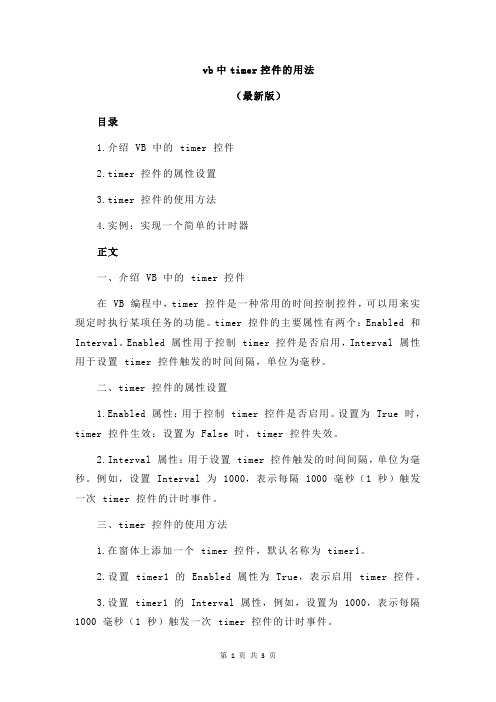
vb中timer控件的用法(最新版)目录1.介绍 VB 中的 timer 控件2.timer 控件的属性设置3.timer 控件的使用方法4.实例:实现一个简单的计时器正文一、介绍 VB 中的 timer 控件在 VB 编程中,timer 控件是一种常用的时间控制控件,可以用来实现定时执行某项任务的功能。
timer 控件的主要属性有两个:Enabled 和Interval。
Enabled 属性用于控制 timer 控件是否启用,Interval 属性用于设置 timer 控件触发的时间间隔,单位为毫秒。
二、timer 控件的属性设置1.Enabled 属性:用于控制 timer 控件是否启用。
设置为 True 时,timer 控件生效;设置为 False 时,timer 控件失效。
2.Interval 属性:用于设置 timer 控件触发的时间间隔,单位为毫秒。
例如,设置 Interval 为 1000,表示每隔 1000 毫秒(1 秒)触发一次 timer 控件的计时事件。
三、timer 控件的使用方法1.在窗体上添加一个 timer 控件,默认名称为 timer1。
2.设置 timer1 的 Enabled 属性为 True,表示启用 timer 控件。
3.设置 timer1 的 Interval 属性,例如,设置为 1000,表示每隔1000 毫秒(1 秒)触发一次 timer 控件的计时事件。
4.在代码中编写 timer 控件的计时事件处理程序,例如,编写一个名为 timer1_Timer 的子程序。
5.在 timer1_Timer 子程序中编写需要定时执行的任务代码。
四、实例:实现一个简单的计时器1.在窗体上添加一个 timer 控件,命名为 timer1。
2.设置 timer1 的 Enabled 属性为 True,Interval 属性为 1000。
3.编写 timer1_Timer 子程序,代码如下:```Private Sub timer1_Timer()Dim a As Integera = a + 1If a > 10 Thena = 0Label1.Caption = "计时结束"ElseLabel1.Caption = "计时中"End IfEnd Sub```在这个实例中,我们使用了一个名为 Label1 的标签控件来显示计时信息。
C#中的Timer和DispatcherTimer使用实例
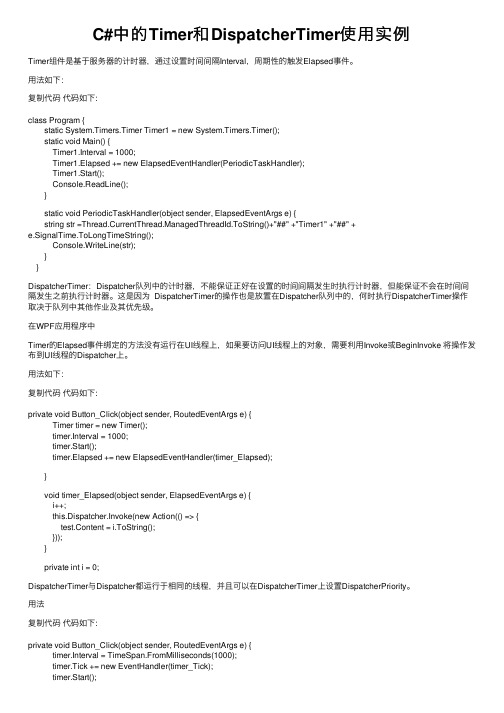
C#中的Timer和DispatcherTimer使⽤实例Timer组件是基于服务器的计时器,通过设置时间间隔Interval,周期性的触发Elapsed事件。
⽤法如下:复制代码代码如下:class Program {static System.Timers.Timer Timer1 = new System.Timers.Timer();static void Main() {Timer1.Interval = 1000;Timer1.Elapsed += new ElapsedEventHandler(PeriodicTaskHandler);Timer1.Start();Console.ReadLine();}static void PeriodicTaskHandler(object sender, ElapsedEventArgs e) {string str =Thread.CurrentThread.ManagedThreadId.ToString()+"##" +"Timer1" +"##" +e.SignalTime.ToLongTimeString();Console.WriteLine(str);}}DispatcherTimer:Dispatcher队列中的计时器,不能保证正好在设置的时间间隔发⽣时执⾏计时器,但能保证不会在时间间隔发⽣之前执⾏计时器。
这是因为 DispatcherTimer的操作也是放置在Dispatcher队列中的,何时执⾏DispatcherTimer操作取决于队列中其他作业及其优先级。
在WPF应⽤程序中Timer的Elapsed事件绑定的⽅法没有运⾏在UI线程上,如果要访问UI线程上的对象,需要利⽤Invoke或BeginInvoke 将操作发布到UI线程的Dispatcher上。
⽤法如下:复制代码代码如下:private void Button_Click(object sender, RoutedEventArgs e) {Timer timer = new Timer();timer.Interval = 1000;timer.Start();timer.Elapsed += new ElapsedEventHandler(timer_Elapsed);}void timer_Elapsed(object sender, ElapsedEventArgs e) {i++;this.Dispatcher.Invoke(new Action(() => {test.Content = i.ToString();}));}private int i = 0;DispatcherTimer与Dispatcher都运⾏于相同的线程,并且可以在DispatcherTimer上设置DispatcherPriority。
使用计时器控件(Timer)PPT课件

If RadioButton2.Checked = True Then a = "宋体"
End If
If RadioButton3.Checked = True Then a = "隶书"
End If
TextBox1.Font = New Font(a, 12, FontStyle.Regular)
-
8
Private Sub RadioButton6_CheckedChanged(ByVal sender As System.Object, ByVal e As System.EventArgs) Handles RadioButton6.CheckedChanged
If RadioButton1.Checked = True Then a = "黑体"
End Sub
Private Sub Timer1_Tick(ByVal sender As System.Object, ByVal e As System.EventArgs) Handles Timer1.Tick
Dim d As Date = Date.Now
Dim t As String = d.ToLongTimeString
End Sub
-
10
Private Sub RadioButton4_CheckedChanged(ByVal sender As System.Object, ByVal e As System.EventArgs) Handles RadioButton4.CheckedChanged
If RadioButton1.Checked = True Then a = "黑体"
C程序中对时间的处理——time库函数详解

一、在C语言中有time_t, tm, timeval等几种类型的时间1、time_ttime_t实际上是长整数类型,定义为:typedef long time_t; /* time value */2、timevaltimeval是一个结构体,在time.h中定义为:struct timeval{__time_t tv_sec; /* Seconds. */__suseconds_t tv_usec; /* Microseconds. */};其中,tv_sec为Epoch(1970-1-1零点零分)到创建struct timeval时的秒数,tv_usec为微秒数,即秒后面的零头。
3、tmtm是一个结构体,定义为:struct tm{int tm_sec; /*代表目前秒数,正常范围为0-59,但允许至61秒 */ int tm_min; /*代表目前分数,范围0-59*/int tm_hour; /* 从午夜算起的时数,范围为0-23 */int tm_mday; /* 目前月份的日数,范围01-31 */int tm_mon; /*代表目前月份,从一月算起,范围从0-11 */int tm_year; /*从1900 年算起至今的年数*/int tm_wday; /* 一星期的日数,从星期一算起,范围为0-6。
*/int tm_yday; /* Days in year.[0-365] */int tm_isdst; /*日光节约时间的旗标DST. [-1/0/1]*/};二、具体操作函数time()函数原型:time_t time(time_t * timer)功能: 获取当前的系统时间,返回的结果是一个time_t类型,其实就是一个大整数,其值表示从CUT(Coordinated Universal Time)时间1970年1月1日00:00:00(称为UNIX系统的Epoch时间)到当前时刻的秒数。
c语言中time.h用法详解
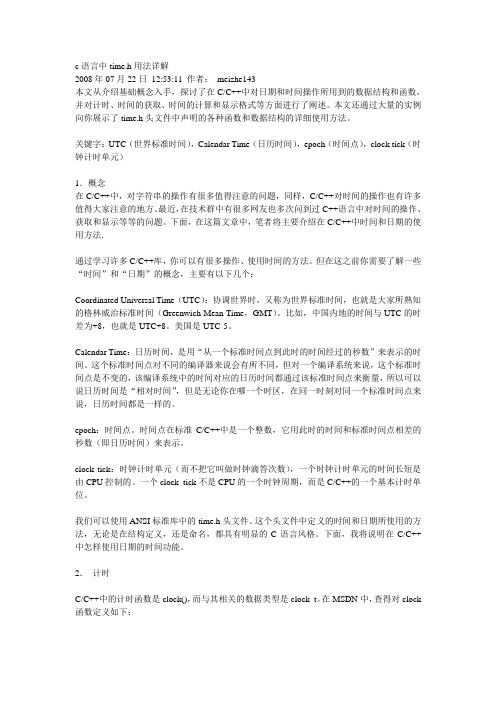
c语言中time.h用法详解2008年07月22日12:53:11 作者:meizhe143本文从介绍基础概念入手,探讨了在C/C++中对日期和时间操作所用到的数据结构和函数,并对计时、时间的获取、时间的计算和显示格式等方面进行了阐述。
本文还通过大量的实例向你展示了time.h头文件中声明的各种函数和数据结构的详细使用方法。
关键字:UTC(世界标准时间),Calendar Time(日历时间),epoch(时间点),clock tick(时钟计时单元)1.概念在C/C++中,对字符串的操作有很多值得注意的问题,同样,C/C++对时间的操作也有许多值得大家注意的地方。
最近,在技术群中有很多网友也多次问到过C++语言中对时间的操作、获取和显示等等的问题。
下面,在这篇文章中,笔者将主要介绍在C/C++中时间和日期的使用方法.通过学习许多C/C++库,你可以有很多操作、使用时间的方法。
但在这之前你需要了解一些“时间”和“日期”的概念,主要有以下几个:Coordinated Universal Time(UTC):协调世界时,又称为世界标准时间,也就是大家所熟知的格林威治标准时间(Greenwich Mean Time,GMT)。
比如,中国内地的时间与UTC的时差为+8,也就是UTC+8。
美国是UTC-5。
Calendar Time:日历时间,是用“从一个标准时间点到此时的时间经过的秒数”来表示的时间。
这个标准时间点对不同的编译器来说会有所不同,但对一个编译系统来说,这个标准时间点是不变的,该编译系统中的时间对应的日历时间都通过该标准时间点来衡量,所以可以说日历时间是“相对时间”,但是无论你在哪一个时区,在同一时刻对同一个标准时间点来说,日历时间都是一样的。
epoch:时间点。
时间点在标准C/C++中是一个整数,它用此时的时间和标准时间点相差的秒数(即日历时间)来表示。
clock tick:时钟计时单元(而不把它叫做时钟滴答次数),一个时钟计时单元的时间长短是由CPU控制的。
c中timer的用法
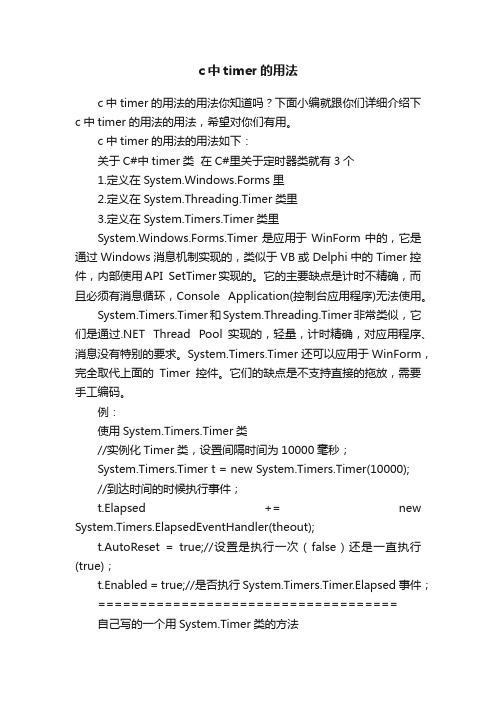
c中timer的用法c中timer的用法的用法你知道吗?下面小编就跟你们详细介绍下c中timer的用法的用法,希望对你们有用。
c中timer的用法的用法如下:关于C#中timer类在C#里关于定时器类就有3个1.定义在System.Windows.Forms里2.定义在System.Threading.Timer类里3.定义在System.Timers.Timer类里System.Windows.Forms.Timer是应用于WinForm中的,它是通过Windows消息机制实现的,类似于VB或Delphi中的Timer控件,内部使用API SetTimer实现的。
它的主要缺点是计时不精确,而且必须有消息循环,Console Application(控制台应用程序)无法使用。
System.Timers.Timer和System.Threading.Timer非常类似,它们是通过.NET Thread Pool实现的,轻量,计时精确,对应用程序、消息没有特别的要求。
System.Timers.Timer还可以应用于WinForm,完全取代上面的Timer控件。
它们的缺点是不支持直接的拖放,需要手工编码。
例:使用System.Timers.Timer类//实例化Timer类,设置间隔时间为10000毫秒;System.Timers.Timer t = new System.Timers.Timer(10000);//到达时间的时候执行事件;t.Elapsed += new System.Timers.ElapsedEventHandler(theout);t.AutoReset = true;//设置是执行一次(false)还是一直执行(true);t.Enabled = true;//是否执行System.Timers.Timer.Elapsed事件;====================================自己写的一个用System.Timer类的方法复制代码代码如下:public class BF_CheckUpdate{private static object LockObject = new Object();// 定义数据检查Timerprivate static Timer CheckUpdatetimer = new Timer();// 检查更新锁private static int CheckUpDateLock = 0;////// 设定数据检查Timer参数///internal static void GetTimerStart(){// 循环间隔时间(10分钟)CheckUpdatetimer.Interval = 600000;// 允许Timer执行CheckUpdatetimer.Enabled = true;// 定义回调CheckUpdatetimer.Elapsed += new ElapsedEventHandler(CheckUpdatetimer_Elapsed);// 定义多次循环CheckUpdatetimer.AutoReset = true;}////// timer事件/////////private static void CheckUpdatetimer_Elapsed(object sender, ElapsedEventArgs e){// 加锁检查更新锁lock (LockObject){if (CheckUpDateLock == 0) CheckUpDateLock = 1; else return;}//More code goes here.//具体实现功能的方法Check();// 解锁更新检查锁lock (LockObject){CheckUpDateLock = 0;}}}。
C MFC中定时器的使用
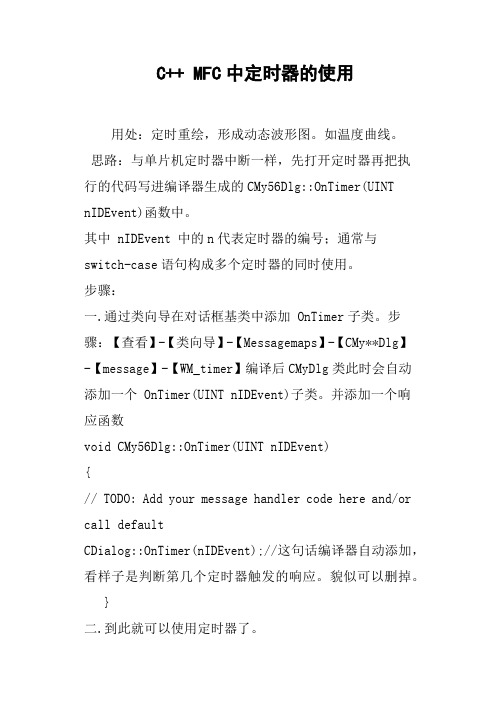
C++ MFC中定时器的使用用处:定时重绘,形成动态波形图。
如温度曲线。
思路:与单片机定时器中断一样,先打开定时器再把执行的代码写进编译器生成的CMy56Dlg::OnTimer(UINT nIDEvent)函数中。
其中 nIDEvent 中的n代表定时器的编号;通常与switch-case语句构成多个定时器的同时使用。
步骤:一.通过类向导在对话框基类中添加 OnTimer子类。
步骤:【查看】-【类向导】-【Messagemaps】-【CMy**Dlg】-【message】-【WM_timer】编译后CMyDlg类此时会自动添加一个 OnTimer(UINT nIDEvent)子类。
并添加一个响应函数void CMy56Dlg::OnTimer(UINT nIDEvent){// TODO: Add your message handler code here and/or call defaultCDialog::OnTimer(nIDEvent);//这句话编译器自动添加,看样子是判断第几个定时器触发的响应。
貌似可以删掉。
}二.到此就可以使用定时器了。
使用方法:首先执行SetTimer(UINT nIDEvent,timer,NULL);其中UINT nIDEvent是定时器编号,需自己设定想用定时器1就设为1。
雷同于单片机的定时器1和2。
timer是uint型,表示定时时间,单位为ms.NULL保留。
然后添加中断函数如下:void CMy56Dlg::OnTimer(UINT nIDEvent){// TODO: Add your message handler code here and/or call defaultCDialog::OnTimer(nIDEvent);}三:例子假定用的是定时器一,定时1s:1.【查看】-【类向导】-【Messagemaps】-【CMy**Dlg】-【message】-【WM_timer】并编译2.开启定时器:SetTimer(1,1000,NULL);//定时器一,定时一秒。
- 1、下载文档前请自行甄别文档内容的完整性,平台不提供额外的编辑、内容补充、找答案等附加服务。
- 2、"仅部分预览"的文档,不可在线预览部分如存在完整性等问题,可反馈申请退款(可完整预览的文档不适用该条件!)。
- 3、如文档侵犯您的权益,请联系客服反馈,我们会尽快为您处理(人工客服工作时间:9:00-18:30)。
C#中Timer组件用法Timer组件是也是一个WinForm组件了,和其他的WinForm组件的最大区别是:Timer组件是不可见的,而其他大部分的组件都是都是可见的,可以设计的。
Timer组件也被封装在名称空间System.Windows.Forms中,其主要作用是当Timer组件启动后,每隔一个固定时间段,触发相同的事件。
Timer组件在程序设计中是一个比较常用的组件,虽然属性、事件都很少,但在有些地方使用它会产生意想不到的效果。
其实要使得程序的窗体飘动起来,其实思路是比较简单的。
首先是当加载窗体的时候,给窗体设定一个显示的初始位置。
然后通过在窗体中定义的二个Timer组件,其中一个叫Timer1,其作用是控制窗体从左往右飘动(当然如果你愿意,你也可以改为从上往下飘动,或者其他的飘动方式。
),另外一个Timer2是控制窗体从右往左飘动(同样你也可以改为其他飘动方式)。
当然这二个Timer 组件不能同时启动,在本文的程序中,是先设定Timer1组件启动的,当此Timer1启动后,每隔0.01秒,都会在触发的事件中给窗体的左上角的横坐标都加上"1",这时我们看到的结果是窗体从左往右不断移动,当移动到一定的位置后,Timer1停止。
Timer2启动,每隔0.01秒,在触发定义的事件中给窗体的左上角的横坐标都减去"1",这时我们看到的结果是窗体从右往左不断移动。
当移动到一定位置后,Timer1启动,Timer2停止,如此反覆,这样窗体也就飘动起来了。
要实现上述思路,必须解决好以下问题。
(1).如何设定窗体的初始位置:设定窗体的初始位置,是在事件Form1_Load()中进行的。
此事件是当窗体加载的时候触发的。
Form有一个DesktopLocation属性,这个属性是设定窗体的左上角的二维位置。
在程序中是通过Point结构变量来设定此属性的值,具体如下://设定窗体起初飘动的位置,位置为屏幕的坐标的(0,240)private void Form1_Load ( object sender , System.EventArgs e ){Point p = new Point ( 0 , 240 ) ;this.DesktopLocation = p ;}(2). 如何实现窗体从左往右飘动:设定Timer1的Interval值为"10",就是当Timer1启动后,每隔0.01秒触发的事件是Timer1_Tick(),在这个事件中编写给窗体左上角的横坐标不断加"1"的代码,就可以了,具体如下:private void timer1_Tick(object sender, System.EventArgs e){{ //窗体的左上角横坐标随着timer1不断加一Point p = new Point ( this.DesktopLocation.X + 1 ,this.DesktopLocation.Y ) ;this.DesktopLocation = p ;if ( p.X == 550 ){timer1.Enabled = false ;timer2.Enabled = true ;}}(3). 如何实现窗体从右往左飘动:代码设计和从左往右飘动差不多,主要的区别是减"1"而不是加"1"了,具体如下://当窗体左上角位置的横坐标为-150时,timer2停止,timer1启动private void timer2_Tick(object sender, System.EventArgs e){ file://窗体的左上角横坐标随着timer2不断减一Point p = new Point ( this.DesktopLocation.X - 1 ,this.DesktopLocation.Y ) ;this.DesktopLocation = p ;if ( p.X == - 150 ){timer1.Enabled = true ;timer2.Enabled = false ;}}三.用Visual C#编写窗体飘动程序的源代码:通过上面的介绍,不难写出窗体飘动的程序源代码。
如下:using System ;using System.Drawing ;using System.Collections ;using ponentModel ;using System.Windows.Forms ;using System.Data ;namespace floatingForm{public class Form1 : Formprivate Timer timer1 ;private Timer timer2 ;private Label label1 ;private Button button1 ;private ponentModel.IContainer components ;public Form1 ( ){file://初始化窗体中的各个组件InitializeComponent ( ) ;}file://清除在程序中使用过的资源protected override void Dispose ( bool disposing ){if ( disposing ){if ( components != null ){components.Dispose ( ) ;}}base.Dispose( disposing ) ;}private void InitializeComponent ( ){ponents = new ponentModel.Container ( ) ;this.timer1 = new Timer ( ponents ) ;this.timer2 = new Timer ( ponents ) ;bel1 = new Label ( ) ;this.button1 = new Button ( ) ;this.SuspendLayout ( ) ;this.timer1.Enabled = true ;this.timer1.Interval = 10 ;this.timer1.Tick += new System.EventHandler ( this.timer1_Tick ) ;this.timer2.Enabled = false ;this.timer2.Interval = 10 ;this.timer2.Tick += new System.EventHandler ( this.timer2_Tick ) ;this.button1.Font = new Font ( "宋体" , 10 ) ;this.button1.Location = new Point ( 1 , 8 ) ; = "button1" ;this.button1.Size = new Size ( 80 , 25 ) ;this.button1.TabIndex = 0 ;this.button1.Text = "停止飘动" ;this.button1.Click += new System.EventHandler ( this.button1_Click ) ;bel1.Font = new Font ( "宋体" , 22F , FontStyle.Bold , GraphicsUnit.Point , ( ( System.Byte ) ( 0 ) ) ) ;bel1.Location = new Point ( 8 , 38 ) ; = "label1" ;bel1.Size = new Size ( 344 , 40 ) ;bel1.TabIndex = 1 ;bel1.Text = "用Visual C#做的飘动的窗体!" ;this.AutoScaleBaseSize = new Size ( 5 , 13 ) ;this.ClientSize = new Size ( 352 , 70 ) ;this.Controls.Add (bel1 ) ;this.Controls.Add (this.button1 ) ; = "Form1" ;this.Text = "用Visual C#做的飘动的窗体!";this.Load += new System.EventHandler ( this.Form1_Load ) ;this.ResumeLayout ( false ) ;}static void Main ( ){Application.Run ( new Form1 ( ) ) ;}file://设定窗体起初飘动的位置private void Form1_Load ( object sender , System.EventArgs e ){Point p = new Point ( 0 , 240 ) ;this.DesktopLocation = p ;}file://当窗体左上角位置的横坐标为550时,timer1停止,timer2启动private void timer1_Tick(object sender, System.EventArgs e){file://窗体的左上角横坐标随着timer1不断加一Point p = new Point ( this.DesktopLocation.X + 1 ,this.DesktopLocation.Y ) ;this.DesktopLocation = p ;if ( p.X == 550 ){timer1.Enabled = false ;timer2.Enabled = true ;}}file://当窗体左上角位置的横坐标为-150时,timer2停止,timer1启动private void timer2_Tick(object sender, System.EventArgs e){ file://窗体的左上角横坐标随着timer2不断减一Point p = new Point ( this.DesktopLocation.X - 1 ,this.DesktopLocation.Y ) ;this.DesktopLocation = p ;if ( p.X == - 150 ){timer1.Enabled = true ;timer2.Enabled = false ;}}file://停止所有的timerprivate void button1_Click(object sender, System.EventArgs e){timer1.Stop ( ) ;timer2.Stop ( ) ;}}}四.总结:恰到好处的使用Timer组件往往会有出其不意的效果。
